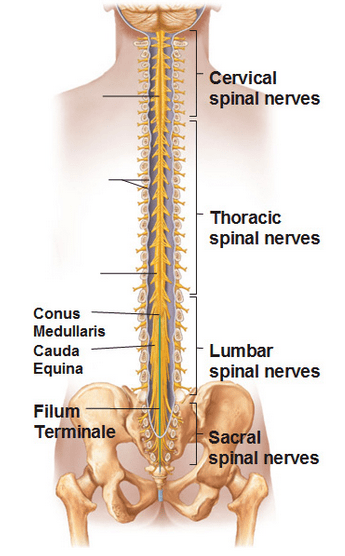SPINAL CORD INJURIES & DISORDERS
A spinal cord injury, caused by trauma or otherwise, can be incredibly frightening and halt your daily activities for days, weeks, or months if left untreated. Your spinal cord is essentially a bundle of nerves that are constantly sending signals back and forth between your body and your brain. Once that signal is disrupted, medical attention, physical therapy, or medication is necessary to prevent life-long disability.

 Myelopathy
Myelopathy
Myelopathy occurs when there is any kind of loss of spinal cord functionality, though it more commonly occurs due to trauma or deteriorating changes that the spine undergoes. Most commonly, myelopathy is seen in the elderly, but it can develop due to compression of the spinal cord if discs are herniated in the back or from bone spurs. If there is compression of the spinal cord that develops, it is usually due to direct trauma like from an accident or other incident. Myleopathy is most commonly seen in the neck, but it could also affect the lower back.
Symptoms & Treatment
Not treating myelopathy can result in significant disability for patients, and will result in irreversible damage to the spinal cord. Those that have myelopathy often exhibit symptoms like loss of balance or difficulty walking, but the symptoms may be hard to detect, because they manifest gradually in patients. Treatment for myelopathy depends, but typically many resort to surgery. Surgery is used to lessen the amount of pressure that the spinal cord is under, while decreasing pain. For those that prefer non-operative options, physical therapy or medication is used to help ease pain for patients.
Spinal Stenosis
 Spinal stenosis develops when the spine changes with age. There are two different diagnoses:
Spinal stenosis develops when the spine changes with age. There are two different diagnoses:
- Lumbar stenosis – affects the lower back and walking
- Cervical stenosis – concerns the neck
Symptoms & Treatment
Symptoms of spinal stenosis include numbness, muscle weakness, lower back and buttocks pain, and sometimes impaired bladder or bowel control. Relieving the pressure on the spine will usually help alleviate symptoms or pain that is being experienced. Those who have lumbar stenosis will often find relief through non-surgical approaches like activity modification, exercise through a physical therapist or epidural injections. In cervical stenosis, the only effective way to treat it is through decompression surgery of the spine.
Lumbar Stenosis
For many people, spinal stenosis is characterized by leg pain that appears while walking, or weakness with walking. Many will find relief when they are sitting or in a leaning forward position, like over a shopping cart or with a cane. Those with lumbar stenosis will have pain while walking, which stops once they are able to sit down.
Symptoms & Treatment
Treatment can vary, but many patients with lumbar stenosis will try activity modification, physical therapist guided exercises, NSAIDs like Advil or Tylenol, and epidural injections, which are used for quick and temporary pain relief. If those don’t work, surgery is the next option, especially if the patient is finding their quality of life being significantly impacted by their pain. The most common surgery is a lumbar laminectomy, which has an extremely high success rate of around 80%, and usually leads to patients having a more active and pain free lifestyle.
Cervical Stenosis
Cervical stenosis is a disorder that slowly progresses and pinches the nerves that are in the neck. In the elderly, it is much more common to have cervical spinal stenosis with myelopathy, as the spine becomes compressed.
Symptoms & Treatment
Those with cervical stenosis often have symptoms like arm pain, a heavy feeling in their legs, and shooting pain in the arms and legs. For truly effective treatment, many patients with cervical stenosis undergo decompression surgery. Many people who undergo decompression surgery find that their symptoms improve after recovery, leading to a higher quality of life.
Scoliosis & Adult Scoliosis
Scoliosis occurs when the spine curves abnormally. Some curves can happen naturally with age, but if the spine is curved more than 20 degrees to one side, it’s considered abnormal. Scoliosis affects as many as 4 in 100 adolescents between the ages of 10 and 18. In some scoliosis cases, the cause is not known, though signs almost always point to genetics. Scoliosis is most common in adolescents, but can develop in older adults, too – though it is less common. Most cases of scoliosis are considered to be idiopathic, meaning there is no known cause for how it developed. It can also appear during adulthood if it wasn’t caught or treated during childhood.
Symptoms & Treatment
Adults with scoliosis most often have back pain, though if the thoracic spine is involved, there may also be symptoms of having difficulty breathing. Scoliosis will often exhibit itself with physical deformities like a lack of symmetry throughout the body and trunk imbalance, which will make it seem like the patient is listing to one side.
Unlike scoliosis in children, adult scoliosis can usually be treated without surgery, using treatment options like moist heat, physical therapy and medications to help with pain. If those treatments don’t work, then surgery may be the answer. Spinal surgery usually includes spinal fusion and spinal instrumentation. Once the spine is fused, surgeons may prescribe a bone growth stimulator in order to stimulate bone growth and help produce bone healing. After surgery, patients continue to be treated with physical therapy to help promote proper spine curvature and healing.

